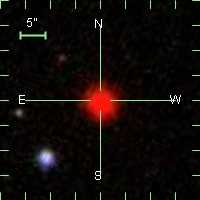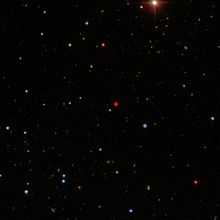AZ Cancri
 Close-up of the SDSS DR6 image with AZ Cnc centered. | |
| Observation data Epoch J2000.0 Equinox J2000.0 (ICRS) | |
|---|---|
| Constellation | Cancer |
| Right ascension | 08h 40m 29.751s[1] |
| Declination | +18° 24′ 09.18″[1] |
| Apparent magnitude (V) | 17.59[1] |
| Characteristics | |
| Spectral type | M6.5eV[1] |
| U−B color index | −5.1[1] |
| B−V color index | 1.6[1] |
| V−R color index | 1.0[1] |
| R−I color index | 3.2[1] |
| Variable type | UV[2] |
| Astrometry | |
| Proper motion (μ) | RA: −799[1] mas/yr Dec.: −463[1] mas/yr |
| Parallax (π) | 71.1 ± 1[1] mas |
| Distance | 45.9 ± 0.6 ly (14.1 ± 0.2 pc) |
| Absolute magnitude (MV) | 16.85[3] |
| Other designations | |
| Database references | |
| SIMBAD | data |
AZ Cancri (AZ Cnc) is a M-type flare star in the constellation Cancer.[1] It has an apparent visual magnitude of approximately 17.59.[1]
Observations

AZ Cancri is a member of the Beehive Cluster, also known as Praesepe or NGC 2632. The spectral type of AZ Cnc is M6e,[4] specifically M6.5Ve,[5] and was catalogued as a flare star by Haro and Chavira in 1964 (called by them T4).[6][7] AZ Cnc has also been found to be an x-ray source, with the ROSAT designations of RX J0840.4+1824 and 1RXS J084029.9+182417. The X-ray luminosity has been found to be 27.40 ergs/s[8]
Physical characteristics
The absolute magnitude of the star has been found to be 16.9, and thus its luminosity is approximately 3.020 x 1030 ergs/s.
AZ Cancri is located approximately 14.0 parsecs (46 ly) from the Sun, and is considered a very low mass star [9] with a radial velocity of 64.2±0.6 km/s.[10] AZ Cancri belongs kinematically to the old disk.[10] It is rotating at approximately 7.9±2.8 km/s.[10]
Flaring
The X-ray luminosity of AZ Cnc increased by at least two orders of magnitude during a flare that lasted more than 3 h and reached a peak emission level of more than 1029 ergs/s.[8] During another long duration flare (March 14, 2002) on AZ Cnc, very strong wing asymmetries occurred in all lines of the Balmer series and all strong He I lines, but not in the metal lines.[10]
The flaring atmosphere of AZ Cancri has been analysed a with stellar atmosphere model,[11][10] and was found to consist of
- an underlying photosphere,
- a linear temperature rise vs. log column mass in the chromosphere, and
- transition region (TR) with different gradients.[10]
For the underlying photosphere, the effective temperature was found to be 2800 K, and a solar chemical composition was used.[10] The last spectrum taken in the series after the flare was used for the quiescent chromosphere.[10]
The line asymmetries have been attributed to downward moving material,[10] specifically a series of flare-triggered downward moving chromospheric condensations, or chromospheric downward condensations (CDC)s as on the Sun.[12]
Theory of coronal heating
The electrodynamic coupling theory of coronal heating developed in a solar context,[13] has been applied to stellar coronae.[14] A distinctive feature is the occurrence of a resonance between the convective turnover time and the crossing time for Alfvén waves in a coronal loop. The resonance attains a maximum among the early M dwarf spectral types and declines thereafter. A turnover in coronal heating efficiency, presumably manifested by a decrease in Lx/Lbol, becomes evident toward the late M spectral types when the theory is applicable. This is consistent with an apparent lack of X-ray emission among the late M dwarfs.[15] Coronal heating efficiencies do not decrease toward the presumably totally convective stars near the end of the main sequence.[8] For "saturated" M dwarfs, 0.1% of all energy is typically radiated in X-rays, while for AZ Cnc this number increases during flaring to 7%.[8] So far there is no evidence to suggest that AZ Cnc is less efficient than more massive dwarfs in creating a corona.[8] The saturation boundary in X-ray luminosity extends to late M dwarfs, with Lx/Lbol ~ 10−3 for saturated dwarfs outside flaring. No coronal dividing line exists in the Hertzsprung–Russell diagram at the low-mass end of the main sequence.[8]
AZ Cnc casts doubt on the applicability of electrodynamic coupling as there is no evidence for a sharp drop in Lx/Lbol when compared with other late M stars at least until subtype M8.[8]
Dynamo
AZ Cnc has a corona and this may indicate that a distributive dynamo is just as efficient in producing magnetic flux as a shell dynamo.[8] Between the generation of a magnetic field and the emission of X-rays lies the coronal heating mechanism.[8]
References
- ↑ 1.0 1.1 1.2 1.3 1.4 1.5 1.6 1.7 1.8 1.9 1.10 1.11 1.12 1.13 V* AZ Cnc -- Flare Star, database entry, SIMBAD. Accessed on line October 13, 2010.
- ↑ AZ Cnc, database entry, The combined table of GCVS Vols I-III and NL 67-78 with improved coordinates, General Catalogue of Variable Stars, Sternberg Astronomical Institute, Moscow, Russia. Accessed on line October 13, 2010.
- ↑ From apparent magnitude and parallax.
- ↑ Kirkpatrick JD, Henry TJ, McCarthy D (1991). "A standard stellar spectral sequence in the red/near-infrared - Classes K5 to M9". Ap J Suppl Ser. 77: 417. Bibcode:1991ApJS...77..417K. doi:10.1086/191611.
- ↑ Dahn C, Green R, Keel W, Hamilton D, Kallarakal V, Liebert J (Sep 1985). "The Absolute Magnitude of the Flare Star AZ Cancri (LHS 2034)". Information Bull Var Stars. 2796 (9): 1–2. Bibcode:1985IBVS.2796....1D.
- ↑ Bidelman, W. P.; D. Hoffleit. "The Absolute Magnitude of AZ Cancri". Information Bulletin on Variable Stars 2414 (1). Bibcode:1983IBVS.2414....1B.
- ↑ Haro G, Chavira E, Gonzalez G (Dec 1976). "Flare stars in the Praesepe field". Bol Inst Tonantzintla. 2 (12): 95–100. Bibcode:1976BITon...2...95H.
- ↑ 8.0 8.1 8.2 8.3 8.4 8.5 8.6 8.7 8.8 Fleming TA, Giampapa MS, Schmitt JHMM, Bookbinder JA (Jun 1993). "Stellar coronae at the end of the main sequence - A ROSAT survey of the late M dwarfs". Ap J. 410 (1): 387–92. Bibcode:1993ApJ...410..387F. doi:10.1086/172755.
- ↑ Monet DG, Dahn CC, Vrba FJ, Harris HC, Pier JR, Luginbuhl CB, Ables HD (1992). "U.S. Naval Observatory CCD parallaxes of faint stars. I - Program description and first results". Astron J. 103: 638. Bibcode:1992AJ....103..638M. doi:10.1086/116091.
- ↑ 10.0 10.1 10.2 10.3 10.4 10.5 10.6 10.7 10.8 Fuhrmeister B, Schmitt JHMM, Hauschildt PH (Jun 2005). "Detection of red line asymmetries in LHS 2034". Astron Astrophys. 436 (2): 677–86. Bibcode:2005A&A...436..677F. doi:10.1051/0004-6361:20042518.
- ↑ Hauschildt PH, Allard F, Baron E (Feb 1999). "The NextGen Model Atmosphere Grid for 3000<=T_eff<=10,000 K". Ap J. 512 (1): 377–85. arXiv:astro-ph/9807286. Bibcode:1999ApJ...512..377H. doi:10.1086/306745.
- ↑ Fisher GH (Nov 1989). "Dynamics of flare-driven chromospheric condensations". Ap J. 346 (11): 1019–29. Bibcode:1989ApJ...346.1019F. doi:10.1086/168084.
- ↑ Ionson J (1984). "A unified theory of electrodynamic coupling in coronal magnetic loops - The coronal heating problem". Ap J. 276: 357. Bibcode:1984ApJ...276..357I. doi:10.1086/161620.
- ↑ Mullan DJ (1984). "On the possibility of resonant electrodynamic coupling in the coronae of red dwarfs". Ap J. 282: 603. Bibcode:1984ApJ...282..603M. doi:10.1086/162239.
- ↑ Bookbinder, J. A. (1985). Observations of non-thermal radiation from late-type stars (Thesis). Cambridge, MA: Harvard University. Bibcode:1985PhDT........13B. Retrieved 8 December 2014.
| ||||||||||||||||||||||||||||||||||||||||||||||||||||||||||